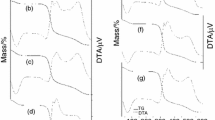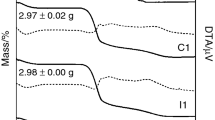Abstract
The Araucaria angustifolia seed, named pinhão, has a high content of carbohydrates, and it is considered an unconventional starch source. Its coats are rich in phenolic compounds, which can be easily extracted with some solvents. This study presents a method of aqueous and ethanolic extraction of phenolic compounds from pinhão coats and its incorporation into corn and pinhão starches. Thermogravimetry, differential scanning calorimetry, X-ray powder diffractometry, Fourier-transform infrared spectroscopy and field emission gun-scanning electron microscopy were applied to evaluate the thermal, structural and morphological properties of starches. The control samples were prepared under the same conditions, with deionised water and ethanol/water 55:45 v/v, without extracts. Starches incorporated with both extracts showed lower thermal decomposition temperatures than the native ones. The gelatinization enthalpy (ΔHgel) of corn starch decreased after incorporation with extracts. The ΔHgel of native pinhão starch was 7.3 J g−1. A higher ΔHgel was observed after treatment with ethanolic extract, while the aqueous extract caused a decrease in this value. Treatments did not change the diffraction patterns but change the relative crystallinity (RC) of starches, except to the samples treated with ethanol/water 55:45 v/v that maintained RC similar to the native ones. There was a good correlation of FTIR data with RC and ΔHgel. After incorporation with ethanolic extract, the pinhão starch showed superficial peeling. No change was observed in morphological characteristics for the other samples. Results indicate that there is an interaction between the phenolic compounds of the pinhão coats and the starch.







Similar content being viewed by others
References
Cordenunsi BR, Wenzel de Menezes E, Genovese MI, Colli C, Gonçalves de Souza A, Lajolo FM. Chemical composition and glycemic index of Brazilian pine (Araucaria angustifolia) seeds. J Agric Food Chem. 2004;52:3412–6. https://doi.org/10.1021/jf034814l.
Bello-Pérez LA, García-Suárez FJ, Méndez-Montealvo G, Oliveira do Nascimento JR, Lajolo FM, Cordenunsi BR. Isolation and characterization of starch from seeds of Araucaria brasiliensis: a novel starch for application in food industry. Starch-Stärke. 2006;58:283–91. https://doi.org/10.1002/star.200500455.
Cladera-Olivera F, Marczak LDF, Noreña CPZ, Pettermann A. Modeling water adsorption isotherms of pinhão (Araucaria Angustifolia seeds) flour and thermodynamic analysis of the adsorption process. J Food Process Eng. 2011;34:826–43. https://doi.org/10.1111/j.1745-4530.2009.00437.x.
Peralta RM, Koehnlein EA, Oliveira RF, Correa VG, Corrêa RCG, Bertonha L, Bracht A, Ferreira ICFR. Biological activities and chemical constituents of Araucaria angustifolia: an effort to recover a species threatened by extinction. Trends Food Sci Technol. 2016;54:85–93.
Zortéa-Guidolin MEB, Demiate IM, de Godoy RCB, de de Paula Scheer A, Grewell D, Jane J. Structural and functional characterization of starches from Brazilian pine seeds (Araucaria angustifolia). Food Hydrocoll. 2017;63:19–26.
Freitas TB, Santos CHK, Silva MV, Shirai MA, Dias MI, Barros L, Barreiro MF, Ferreira ICFR, Gonçalves OH, Leimann FV. Antioxidants extraction from Pinhão (Araucaria angustifolia (Bertol.) Kuntze) coats and application to zein films. Food Packag Shelf Life. 2018;15:28–34.
Daudt RM, Back PI, Cardozo NSM, Marczak LDF, Külkamp-Guerreiro IC. Pinhão starch and coat extract as new natural cosmetic ingredients: topical formulation stability and sensory analysis. Carbohydr Polym. 2015;134:573–80.
Behling E, Sendão MC, Francescato HDC, Antunes L, Bianchi ML. Flavonóide quercetina: aspectos gerais e ações biológicas. Aliment e Nutr. 2008;15:285–92.
Daudt RM, Külkamp-Guerreiro IC, Cladera-Olivera F, Thys RCS, Marczak LDF. Determination of properties of pinhão starch: analysis of its applicability as pharmaceutical excipient. Ind Crops Prod. 2014;52:420–9.
Mota GST, Arantes AB, Sacchetti G, Spagnoletti A, Ziosi P, Scalambra E, Vertuani S, Manfredini S. Antioxidant activity of cosmetic formulations based on novel extracts from seeds of Brazilian Araucaria angustifolia (Bertoll) Kuntze. J Cosmet Dermatological Sci Appl. 2014;04:190–202.
Santos CHK, Baqueta MR, Coqueiro A, Dias MI, Barros L, Barreiro MF, Ferreira ICFR, Gonçalves OH, Bona E, Silva MV, Leimann FV. Systematic study on the extraction of antioxidants from pinhão (Araucaria angustifolia (bertol.) Kuntze) coat. Food Chem. 2018;261:216–23.
Somaratne GM, Prasantha BDR, Dunuwila GR, Chandrasekara A, Wijesinghe DGNG, Gunasekara DCS. Effect of polishing on glycemic index and antioxidant properties of red and white basmati rice. Food Chem. 2017;237:716–23.
Kim Y, Keogh J, Clifton P. Polyphenols and glycemic control. Nutrients. 2016;8:17.
Guzar I, Ragaee S, Seetharaman K. Mechanism of hydrolysis of native and cooked starches from different botanical sources in the presence of tea extracts. J Food Sci. 2012;77:C1192–6. https://doi.org/10.1111/j.1750-3841.2012.02929.x.
Zhu F, Cai Y-Z, Sun M, Corke H. Effect of phytochemical extracts on the pasting, thermal, and gelling properties of wheat starch. Food Chem. 2009;112:919–23.
Xiao H, Lin Q, Liu G-Q, Wu Y, Wu W, Fu X. Inhibitory effects of green tea polyphenols on the retrogradation of starches from different botanical sources. Food Bioprocess Technol. 2013;6:2177–81.
Zhu F. Interactions between starch and phenolic compound. Trends Food Sci Technol. 2015;43:129–43.
Klein B, Pinto VZ, Vanier NL, da Rosa Zavareze E, Colussi R, Evangelho JA, Gutkoski LC, Dias ARG. Effect of single and dual heat–moisture treatments on properties of rice, cassava, and pinhao starches. Carbohydr Polym. 2013;98:1578–84.
Alcázar-Alay SC, Meireles MAA. Physicochemical properties, modifications and applications of starches from different botanical sources. Food Sci Technol. 2015;35:215–36.
Lacerda LG, da Silva Carvalho Filho MA, Bauab T, Demiate IM, Colman TAD, Andrade MMP, Schnitzler E. The effects of heat-moisture treatment on avocado starch granules. J Therm Anal Calorim. 2015;120:387–93. https://doi.org/10.1007/s10973-014-3987-9.
Farias FO, Jasko AC, Colman TAD, Pinheiro LA, Schnitzler E, Barana AC, Demiate IM. Characterisation of cassava bagasse and composites prepared by blending with low-density polyethylene. Brazilian Arch Biol Technol. 2014;57:821–30.
Granza AG, Travalini AP, Farias FO, Colman TAD, Schnitzler E, Demiate IM. Effects of acetylation and acetylation–hydroxypropylation (dual-modification) on the properties of starch from Carioca bean (Phaseolus vulgaris L.). J Therm Anal Calorim. 2015;119:769–77. https://doi.org/10.1007/s10973-014-4092-9.
Luchese CL, Frick JM, Patzer VL, Spada JC, Tessaro IC. Synthesis and characterization of biofilms using native and modified pinhão starch. Food Hydrocoll. 2015;45:203–10.
Spada JC, Noreña CPZ, Marczak LDF, Tessaro IC. Study on the stability of β-carotene microencapsulated with pinhão (Araucaria angustifolia seeds) starch. Carbohydr Polym. 2012;89:1166–73.
Pinto VZ, Vanier NL, Deon VG, Moomand K, El Halal SLM, Zavareze ER, Lim LT, Dias ARG. Effects of single and dual physical modifications on pinhão starch. Food Chem. 2015;187:98–105.
Beninca C, Barboza RA, de Oliveira CS, Bet CD, Bisinella RZB, Schnitzler E. Corn and pinhão starches modified with sodium tripolyphosphate: thermal, pasting, structural and morphological properties. Starch-Stärke. 2019. https://doi.org/10.1002/star.201800290.
Bet CD, Oliveira CS, Colman TAD, Marinho MT, Lacerda LG, Ramos AP, Schnitzler E. Organic amaranth starch: a study of its technological properties after heat-moisture treatment. Food Chem. 2018;264:435–42.
Bet CD, de Oliveira CS, Beninca C, Colman TAD, Lacerda LG, Schnitzler E. Influence of the addition of hydrocolloids on the thermal, pasting and structural properties of starch from common vetch seeds (Vicia sativa sp). J Therm Anal Calorim. 2018;133:549–57. https://doi.org/10.1007/s10973-018-7094-1.
Colman TAD, Demiate IM, Schnitzler E. The effect of microwave radiation on some thermal, rheological and structural properties of cassava starch. J Therm Anal Calorim. 2014;115:2245–52. https://doi.org/10.1007/s10973-012-2866-5.
Dupuis JH, Tsao R, Yada RY, Liu Q. Physicochemical properties and in vitro digestibility of potato starch after inclusion with vanillic acid. LWT-Food Sci Technol. 2017;85:218–24.
Bet CD, Prado Cordoba L, Ribeiro LS, Schnitzler E. Common vetch (Vicia sativa) as a new starch source: its thermal, rheological and structural properties after acid hydrolysis. Food Biophys. 2016;11:275–82. https://doi.org/10.1007/s11483-016-9439-2.
Branco CS, Rodrigues TS. Chemical constituents and biological activities of Araucaria angustifolia (Bertol.) O. Kuntze: a review. J Org Inorg Chem. 2016;2:8.
Oliveira CS, Bet CD, Bisinella RZB, Waiga LH, Colman TAD, Schnitzler E. Heat-moisture treatment (HMT) on blends from potato starch (PS) and sweet potato starch (SPS). J Therm Anal Calorim. 2018;133:1491–8. https://doi.org/10.1007/s10973-018-7196-9.
Chai Y, Wang M, Zhang G. Interaction between amylose and tea polyphenols modulates the postprandial glycemic response to high-amylose maize starch. J Agric Food Chem. 2013;61:8608–15. https://doi.org/10.1021/jf402821r.
Cordoba LP, Bet CD, Schnitzler E. Study by thermal methods of pinhão starch modified with lactic acid. Carpathian J Food Sci Technol. 2015;7:41–4.
Bicudo SCW, Demiate IM, Bannach G, Lacerda LG, Carvalho Filho MAS, Ionashiro M, Schnitzler E. Thermoanalytical study and characterization of native starches of Paraná pine seeds (Araucaria angustiofolia, Bert O. Ktze) and European chestnut seeds (Castanea sativa, Mill). Eclética Química. 2009;34:07–12.
Hornung PS, Rosa da Silveira Lazzarotto S, Bellettini MB, Lazzarotto M, Beta T, Ribani RH, Schnitzler E. Novel oxidized and UV-irradiated Araucaria angustifolia pine seed starch for enhanced functional properties. Starch-Stärke. 2019;71:1800140. https://doi.org/10.1002/star.201800140.
Gutiérrez TJ, Alvarez VA. Bionanocomposite films developed from corn starch and natural and modified nano-clays with or without added blueberry extract. Food Hydrocoll. 2018;77:407–20.
Lozano-Navarro J, Díaz-Zavala N, Velasco-Santos C, Melo-Banda J, Páramo-García U, Paraguay-Delgado FF, García-Alamilla R, Martínez-Hernández A, Zapién-Castillo S. Chitosan-starch films with natural extracts: physical, chemical, morphological and thermal properties. Materials. 2018;11:120.
Wu Y, Chen Z, Li X, Li M. Effect of tea polyphenols on the retrogradation of rice starch. Food Res Int. 2009;42:221–5.
Zhang H, Sun B, Zhang S, Zhu Y, Tian Y. Inhibition of wheat starch retrogradation by tea derivatives. Carbohydr Polym. 2015;134:413–7.
Zhu F, Wang Y-J. Rheological and thermal properties of rice starch and rutin mixtures. Food Res Int. 2012;49:757–62.
Wu Y, Xu H, Lin Q, Wu W, Liu Y. Pasting, thermal and rheological properties of rice starch in aqueous solutions with different catechins. J Food Process Preserv. 2015;39:2074–80. https://doi.org/10.1111/jfpp.12450.
Costa FJOG, Leivas CL, Waszczynskyj N, Godoi RCB, Helm CV, Colman TAD, Schnitzler E. Characterisation of native starches of seeds of Araucaria angustifolia from four germplasm collections. Thermochim Acta. 2013;565:172–7.
Conforti PA, Lupano CE. Starch characterisation of Araucaria angustifolia and Araucaria araucana seeds. Starch-Stärke. 2007;59:284–9. https://doi.org/10.1002/star.200600606.
Cael JJ, Koenig JL, Blackwell J. Infrared and Raman spectroscopy of carbohydrates. Part VI: normal coordinate analysis of V-amylose. Biopolymers. 1975;14:1885–903. https://doi.org/10.1002/bip.1975.360140909.
Kizil R, Irudayaraj J, Seetharaman K. Characterization of irradiated starches by using FT-Raman and FTIR spectroscopy. J Agric Food Chem. 2002;50:3912–8. https://doi.org/10.1021/jf011652p.
Capron I, Robert P, Colonna P, Brogly M, Planchot V. Starch in rubbery and glassy states by FTIR spectroscopy. Carbohydr Polym. 2007;68:249–59.
Pinto VZ, Moomand K, Vanier NL, Colussi R, Villanova FA, Zavareze ER, Lim LT, Dias ARG. Molecular structure and granule morphology of native and heat-moisture-treated pinhão starch. Int J Food Sci Technol. 2015;50:282–9. https://doi.org/10.1111/ijfs.12608.
Zhang G, Ao Z, Hamaker BR. Slow digestion property of native cereal starches. Biomacromolecules. 2006;7:3252–8. https://doi.org/10.1021/bm060342i.
Acknowledgements
The authors would like to thank the Brazilian governmental agencies Coordination for the Improvement of Higher Education Personnel (CAPES) and Programa Uniedu Pós-Graduação, CNPq (Proc. No 307654/2017-6), Araucaria Foundation (Proc. No 16443), for the financial support, and also to thank C-LABMU (UEPG) for help in the analysis.
Author information
Authors and Affiliations
Corresponding author
Additional information
Publisher's Note
Springer Nature remains neutral with regard to jurisdictional claims in published maps and institutional affiliations.
Rights and permissions
About this article
Cite this article
Beninca, C., Bisinella, R.Z.B., Bet, C.D. et al. Effect of aqueous and ethanolic extracts from pinhão coats on the properties of corn and pinhão starches. J Therm Anal Calorim 140, 743–753 (2020). https://doi.org/10.1007/s10973-019-08811-7
Received:
Accepted:
Published:
Issue Date:
DOI: https://doi.org/10.1007/s10973-019-08811-7




